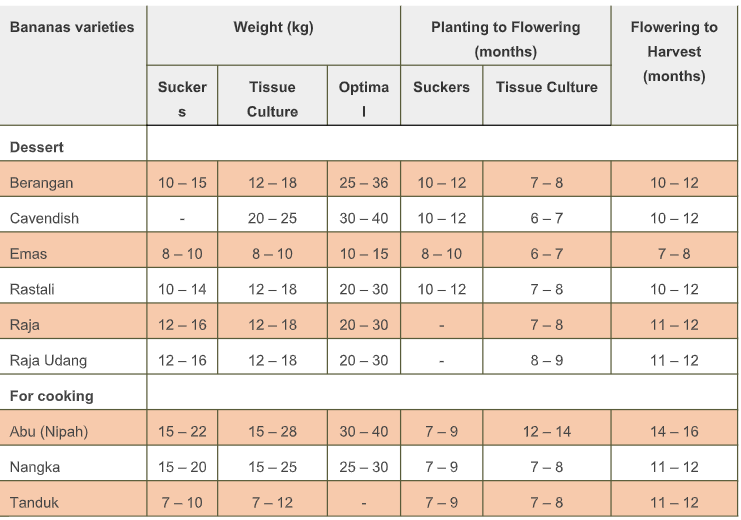Banana Cultivation Information
General Guide in Banana Cultivation
Planting bananas requires skills, dedication, and proper planting methods to achieve high yield. Below are some pertinent guides that any Banana growers should be aware of. The list is not exhaustive and certainly requires some adjustments depending on the variety of the Banana.
1. Agro Climate & Soil
Agro Climate
Bananas need warm subtropical climate, adequate moisture and protection from wind. Most varieties of Bananas grow best with 12 hours of bright light and high humidity of 50% or higher. The ideal temperature range is around 26-30°C (78-86F) with RH regime of 75-85%. Although Bananas grow best in bright sunlight, high temperature will scorch leaves and fruit. Futhermore, wind protection is advisable because high velocity wind which exceeds 80km per hour damages the leaf and the body. Thus, propping should be done during the last few months of its life cycle before harvest.
Soil
Bananas need rich, moisture and well-drained soil. Bananas also prefer a soil with pH between 6 - 7.5. Low pH (below pH 5) soil makes Bananas more susceptible to Panama disease. Avoid soil that is sandy, salty, nutritionally deficient and ill-drained soil. If soil is not in the most favorable condition, improve it! Light sandy soil can be improved by placing mulch around the Banana plants. This will improve water retention and prevent nutrients from percolating quickly into the soil. Nutritionally deficient soil can be improved by incorporating organic matter before planting banana plants. Bananas do not tolerate water logging because its roots will rot. This can be resolved by making ditches while land preparation and planting the Bananas in raised bed.
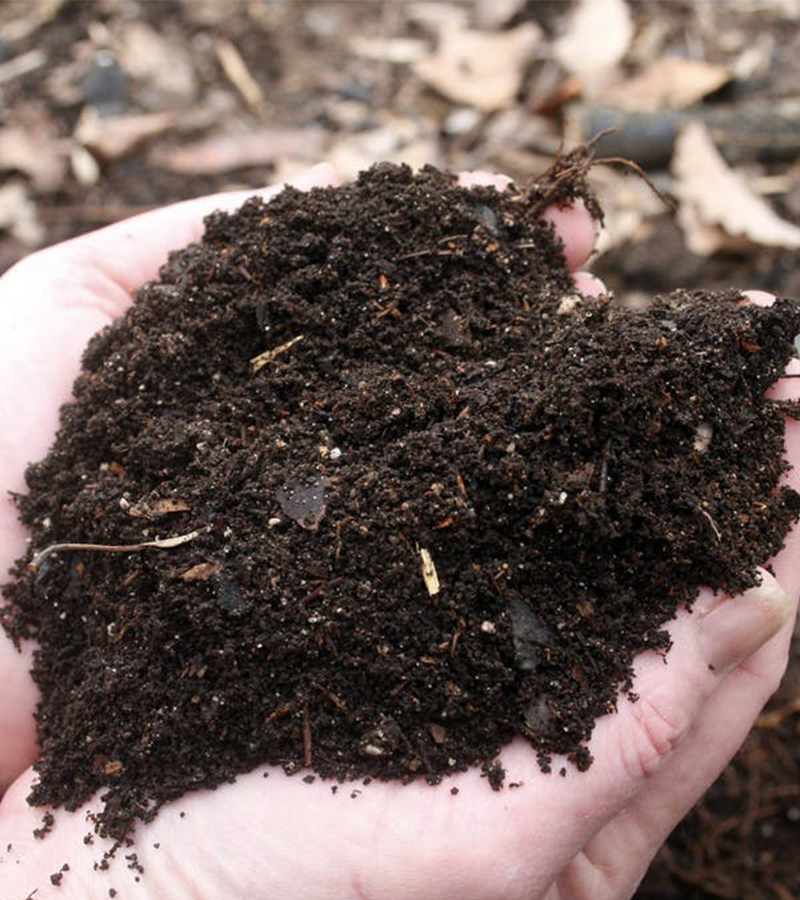
2. Varieties
Varieties There are many varieties of Banana in Malaysia. The commonly cultivated Bananas are Berangan and Canvendish, Rastali, Emas, Raja, Abu (Nipah), Nangka and Tanduk. However, different areas in Malaysia have their own popular cultivated banana variety due to the market demand. For example, Berangan, Rastali and Tanduk are commonly planted in Johor while Nangka and Emas are most popular in Pahang.
The schedule below shows the characteristic of the different varieties. With this information, you will be able to choose the most suitable species for your plantation.
3. Planting
Planting Material
The best way is to start with tissue culture plantlets. Tissue culture plantlets are recommended for planting because they do not contain any soil-borne pathogen and nematodes.
Tissue culture plantlets are healthy, pest and disease free, uniform and shorter harvesting period. Suckers on the contrary are not uniform and have a rather longer-harvesting period thus the management of the plantation is time consuming and uncertain.
Planting Time
Tissue culture Bananas can be planted throughout the year in Malaysia.
Nutrients Supply
Bananas need nitrogen (N), phosphorus (P), potassium (K) with a ratio of 3:1:6 and other micronutrients (Mg, S, B, Ca, Zn, Fe, Cu) to ensure the plants grow vigorously.
Crop Geometry
The recommended spacing is 8 foot x 8 foot with approximately 500 plants per acre since that is the standard distance to minimize the height of plant and diseases, such as Sigatoka. However, the most economical and efficient spacing is 6 foot x 6 foot with 800 plants per acre, if irrigation is available. The diagram below provides a good indication of planting Banana:
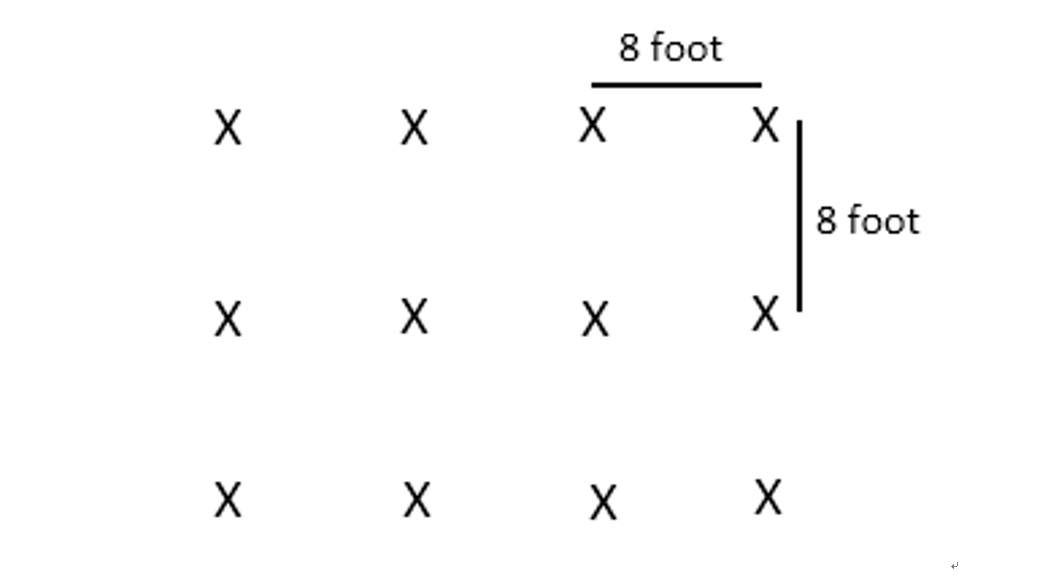
Land Preparation
Good productivity and high quality of banana can only be attained through excellent land preparation. Poor land preparation will increase the risk of pest such as nematodes and disease such as Phytophthora. If the field is going to be planted with banana for the first time, the land is prepared as follow:
- Eliminate all residues of previous crops. Then, burn the demolished and dried plants. If fire is not allowed, a shredder machine is used to cut plants to fine pieces before they are incorporated into soil.
- Add some organic fertilizer and hydrated lime into soil in order to ameliorating the soil quality and reduce the acidity of soil respectively.
- Go over the land once with subsoiler, then go over the land at second time with disc harrow. The main purpose of this work is to break down all soil aggregates and boulder into very fine particles that can facilitate plant growth. This can also incorporate those organic fertilizer and hydrated lime into soil.Planting Method
An appropriate method is required when planting Banana. -
STEP 1
Mark the spots where the plants should be planted by using a long measuring tape.
-
STEP 2
Dig a hole with a foot in diameter and ten (10) to twelve (12) inches deep and place the plants in the hole keeping the pseudo-stem 1 inch below the ground level.
-
STEP 3
Toss a small amount of fertilizer into the hole to boost the growth of the plant and fill the hole with soil. Soil around the plant should be tramped down firmly to remove air pockets.
4. Maintenance
Fertilizer Application
A complete fertilizer with a ratio of 3:1:6 of nitrogen (N), phosphorus (P), potassium (K) is generally suitable for most Banana plantation. Fertilizer should be applied once a fortnight or at least once a month. The best approach is to apply smaller quantity of fertilizer but more frequently. It is advisable to water and apply fertilizer at the same time in order to let Bananas absorb the nutrient faster and easier. If water system is not available, the best time for application of fertilizer is after rain.
The list below is a suggestion of NPK fertilizer application for most varieties of banana (i.e. berangan, rastali, raja, tanduk and nangka). For the other varieties, some adjustments are needed. Furthermore, certain organic fertilizer (e.g. fermented chicken manure and etc.) can also be applied in proper amount and not frequently.
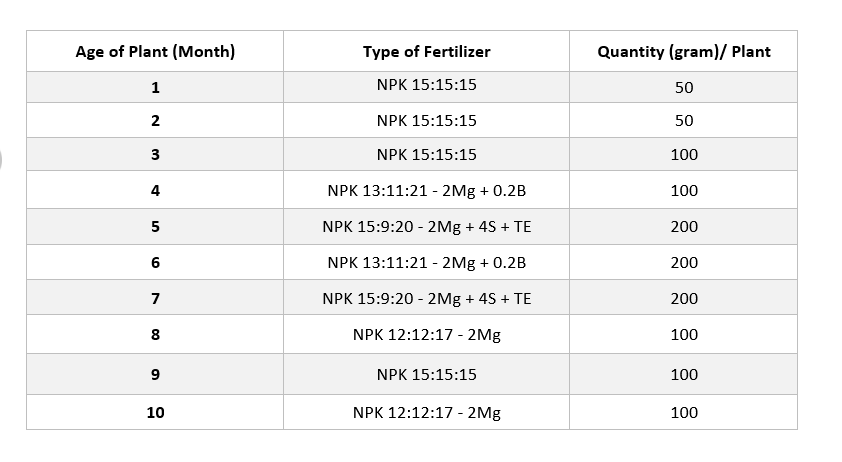
Important note: Apply fertilizer two inches away from the stem of the plant to avoid plant death. On sloping terrain, apply fertilizer only on the uphill side.
Foliar Spray Combined foliar application of micronutrient (i.e. Zn, Fe, Cu, and B) can be also adopted to improve yield of banana. Many brands of foliar micronutrient are available in market. The usage can follow their instruction.
Weeding Do weeding with "Glufosinate-ammonium" when banana plants are young. This is because young banana plants grow notably slower with the presence of weeds which is able to block the sunlight and absorb partial nutrients. However, when banana plants reach mature size, an appropriate number of weeds should be remained because weeds can help in retaining water and preventing fertilizer from leaking. Besides that, weeds can also create a favorite environment for beneficial microorganism that have ability to promote the plant growth and control the growth of harmful microorganism, such as Ralstonia Solanacearum (causing "Moko Disease").
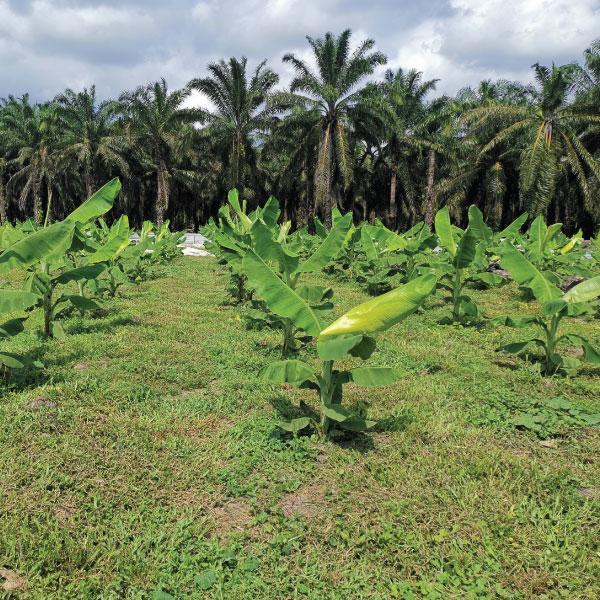
5. Water Management
Water Management - Fertigation Bananas require a great deal of water to grow. The application of water irrigation has proven to increase yield by 20 - 30%. The most efficient manner in water management is dripping irrigation. However, if the banana plants are planted on hill, the sprinkler irrigation is more efficient than dripping irrigation.
Generally, Bananas plantation require a minimum of 2000 - 2500 mm raining annually or 25 mm raining per week. Deep watering is necessary during drought. It is common that Banana plants grow very slow or stop growing if water is short. Although Banana need large amount of water, we do not over water them. Excessive water will also cause roots to rot because banana roots are poor in withdrawing water.
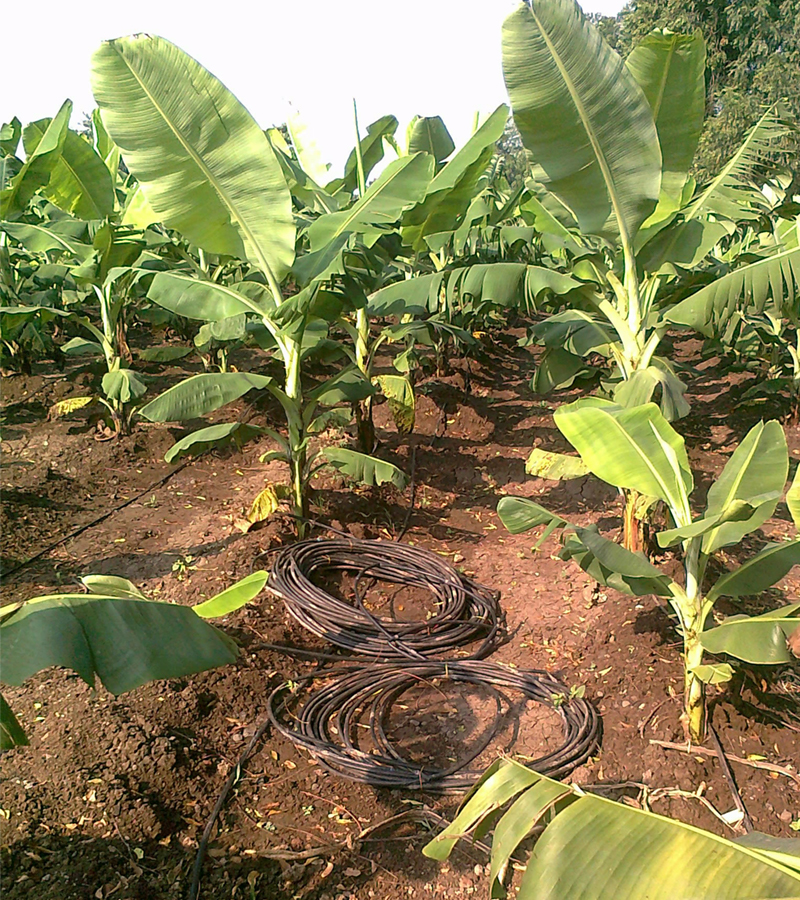
6. Intercrop
Intercropping can be profitable. Short durational crops (45-60 days), like lemongrass, chili and etc. can be planted between rows of banana plants. However, intercropping is only possible during early stage of the plantation.
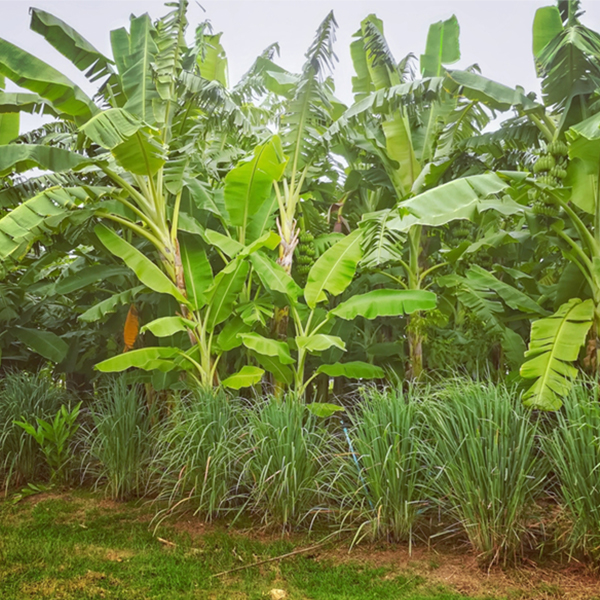
7. Special Operations
The following practices would directly affect the productivity and quality of the Banana.
Desuckering / Pruning of sucker
Keeping too many suckers will reduce yield. It is advisable to remove all suckers once the desired followers have been selected. An age interval of 2 months between the mother plant and the follower is most desirable as these followers will become your main stem after the mother plant fruits. The most effective method to permanently remove unwanted suckers is to cut the stem off the ground and then cut into the center of the plant. This should kill the sucker.
Propagation
Instead of pruning sucker, keeping suckers is a way to propagate banana plant. Suckers can be removed from the clump and replanting it in a newly cultivated land. Large suckers called the "sword sucker" are the preferred planting material. When digging out suckers, their body are often cut to be short and their leaves are removed for easy transportation and re-planting. After that, these suckers are suggested to soak into a solution containing pesticide and fungicide in order to kill insidious worm and fungi. These suckers must be re-planted within a day or two and should not be exposed to the sun. Otherwise the roots may dry up.
Deflowering
Remove the "Bell" (the purple flower petals at the end of the bunch - also known as "banana blossom" or "banana heart"). This is generally practiced because Banana plant will conserve its energy into growing bigger bunch rather than growing longer stalk.
Pruning of leaves
Old leaves and infected leaves should be pruned regularly. This will reduce the likelihood of leaf diseases and keeps the plantation tidy. Furthermore, it provides natural mulch to the Banana plants.
Earthing up
Soil level should be raised after 3 months of planting to keep soil loose. This will also help in growing banana root and preventing plant from falling due to severe wind.
Removal of female hands
While planting Cavendish banana, the last one (1) to two (2) hands of the bunch has to be removed. Banana growers often remove the bottom female hands so that the remaining hands grow bigger as it facilitates fruit development and increases bunch weight. If other varieties of banana (e.g. Berangan, Rastali and Emas) are planted, it does not need to remove their female hands.
Bunch Covering
Bunch covering increases the weigh and enhances quality of fruit. Generally, banana growers use blue plastic sleeves to protect their Bananas from insects, sunburn, diseases, spray residue, dust and birds.
Propping
Support Banana plants with bamboos. Banana plants often go off balance due to the heavy weight of the bunch. Therefore, two (2) bamboos should be propped by placing one (1) against the top of the bunch and the other against the stem on the leaning side. Propping using only one (1) bamboo is not advisable as the Banana plant may plunge to the other direction during strong wind.
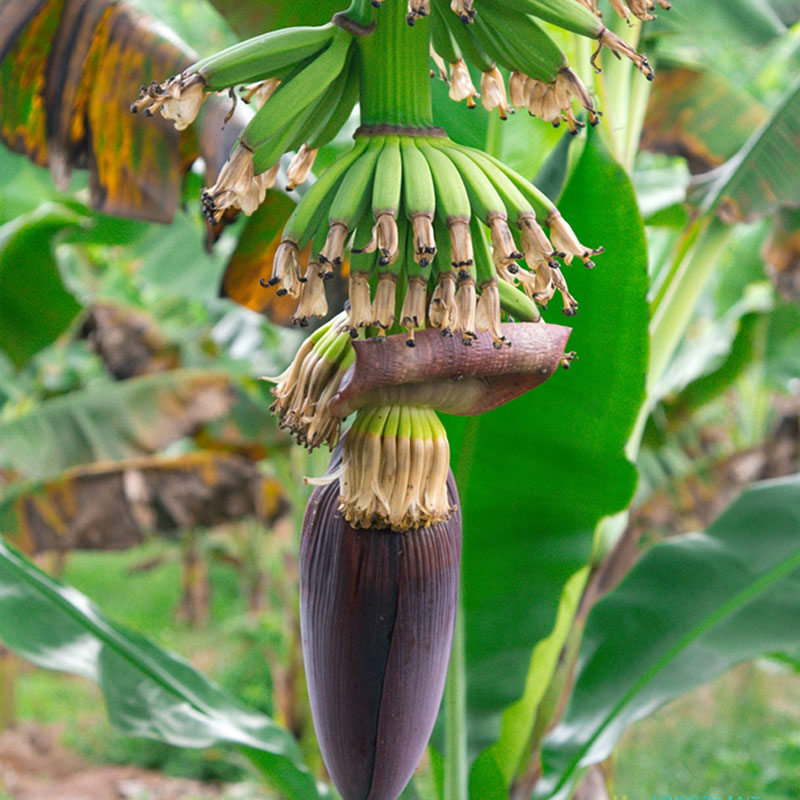
8. Pest and Disease Management
Pest and disease management
Bananas are prompt to viral diseases, fungal diseases and pest thereby reduces production, quality and yield. Pesticide (e.g. Chlorpyrifos, Cypermethrin, and etc.) and Fungicide (e.g. Mancozeb, Chlorothalonil, Propiconazole, and etc.) are suggested to apply monthly to minimize those diseases. Pesticide and fungicide can be mixed together and sprayed onto leaf and body once a month. If manpower is sufficient, we suggest to spray them twice a month to have a better control of diseases. Furthermore, foliar fertilizer can also be mixed with them and sprayed together.
The following table shows the major pest and diseases that Banana growers should be aware of.
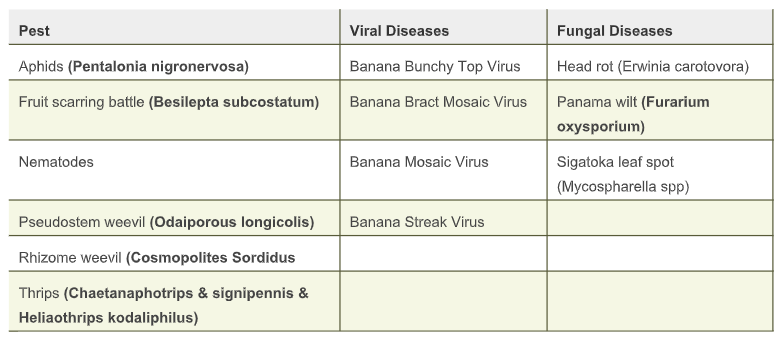
9. Harvesting
Harvest when fingers are fairly evenly rounded. General practice is to harvest when fingers of second hand are ¾ rounded (80% maturity). However, different varieties of banana has different symptom when they are closed to ripen. For example, Berangan Banana should appear yellow color in its fruit pulp when it is closed to ripen. The mother plant should be cut off after harvest as the plant can never produce again.
It is advisable to place harvested bunch in well-padded basket before transporting to the collection site because bananas are easily bruised. Once harvested, the bunch should be kept out of light, in cool and shady place. The process of ripening can be accelerated by using calcium carbide and ethylene. Depending on the demand of the market, Banana hands are often cut into units of 6 - 15 fingers or left on stalks for retail.


